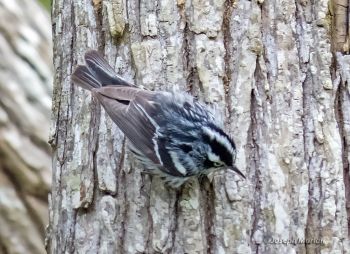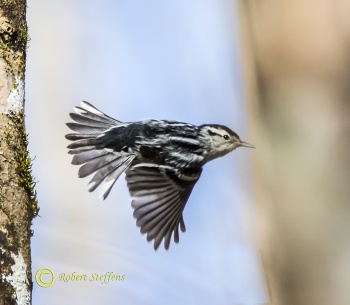- Mniotilta varia
Identification
11–13 cm (4¼-5 in)
Quite distinct; the only black and white striped warbler.
Distribution

Photo © by Joseph Morlan
High Island-Smith Oaks Sanctuary
Bolivar Peninsula, Texas, USA,19 April 2021
Breeds across most of the eastern United States; also in northern and central western Canada. In migration found throughout eastern United States.
Winters south from Mexico to Peru.
Taxonomy
This is a monotypic species[1].
Habitat
Deciduous and mixed forests, particularly in ravines and on hillsides. In migration can be found in most wooded areas.
Behaviour
Acts very much like a Nuthatch, foraging up and down trees.
Diet
Their main diet consists of insects and arthropods. They also occasionally eat fruit in the winter months.
Breeding
They construct a cup-shaped nest from grass, leaves, strips of bark and moss.
References
- Clements, J. F., T. S. Schulenberg, M. J. Iliff, S. M. Billerman, T. A. Fredericks, B. L. Sullivan, and C. L. Wood. 2019. The eBird/Clements Checklist of Birds of the World: v2019. Downloaded from http://www.birds.cornell.edu/clementschecklist/download/
- Curson, J. (2020). Black-and-white Warbler (Mniotilta varia). In: del Hoyo, J., Elliott, A., Sargatal, J., Christie, D.A. & de Juana, E. (eds.). Handbook of the Birds of the World Alive. Lynx Edicions, Barcelona. (retrieved from https://www.hbw.com/node/61496 on 31 January 2020).
Recommended Citation
- BirdForum Opus contributors. (2025) Black-and-white Warbler. In: BirdForum, the forum for wild birds and birding. Retrieved 26 April 2025 from https://www.birdforum.net/opus/Black-and-white_Warbler
External Links
GSearch checked for 2020 platform.1






